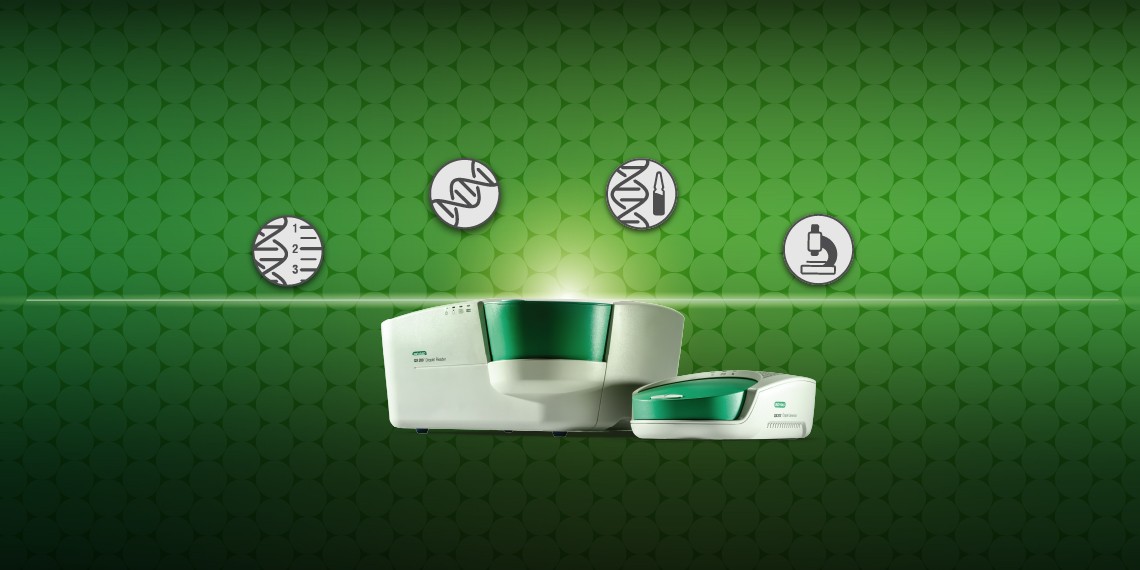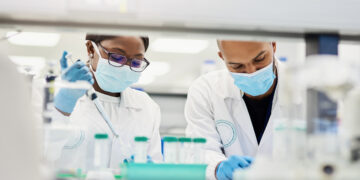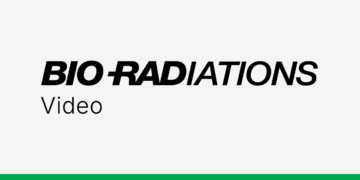From quantifying a patient’s tumor DNA (Li et al. 2018, Klein-Scory et al. 2018), to counting the viral load (Liu et al. 2020) of an individual infected with COVID-19, the breadth of digital PCR (dPCR) applications continues to grow and fulfill critical scientific needs. One of the major advantages the technology confers is the ability to count nucleic acid molecules directly, rather than extrapolating quantity based on standard curves as with many other methods. By harmonizing diagnostic procedures on dPCR platforms, the scientific and medical communities can become more coordinated and efficient than ever before.
Scientists from many different disciplines routinely rely on nucleic acid quantification to conduct molecular testing. Tools to measure nucleic acids (DNA and RNA) have so far been semi-quantitative. But for definitive, quantitative results, metrologists — who study the science of measurement — need a method for counting the actual number of nucleic acid molecules in an experiment. They are exploring the possibility that dPCR might fit the bill. Because many research labs already use dPCR for precise nucleic acid quantification, work is being done to establish it as an official primary reference measurement procedure. This title would encourage labs worldwide to turn to dPCR to reduce variation and bias in their assays, leading to greater standardization of nucleic acid quantification throughout science and medicine.
Setting a Standard
Defining a new primary reference measurement procedure is no small task (Bunk 2007). A method only qualifies as a suitable candidate if its protocol is fully established, understood, and does not require calibration and it is SI-traceable, meaning its calibration can be traced back to a universal certified reference material (NIH 2020).
While real-time quantitative PCR (qPCR) is often considered a gold standard method for measuring DNA, the technique cannot quantify DNA absolutely without being calibrated against standards. A series of dilutions must run alongside each experimental assay to be able to generate a standard curve and interpret the results. While this method is extremely useful in many lab settings, interpretation of results via a standard curve does make the technique susceptible to a higher degree of variability, making it less suitable for the direct quantification of nucleic acids.
For this reason, metrologists have turned their attention to dPCR, such as Bio‑Rad’s Droplet Digital PCR (ddPCR) technology. This technique partitions a PCR reaction into tens of thousands of tiny droplets. Target nucleic acid molecules are then amplified within the droplets and counted by a droplet reader. The ability to count DNA molecules accurately forms the foundation for the acceptance of dPCR as a primary reference measurement procedure. In a recent study, Whale et al. (2018) examined parameters associated with the analytical performance of five different dPCR assays and assay types on five different dPCR platforms, including Bio‑Rad’s QX200 Droplet Digital PCR System. They assessed the trueness of each by comparing dPCR results to an independent, SI-traceable method in order to select a representative dPCR method, assay, and technological platform to fully establish a dPCR protocol, according to International Organization of Standards requirements (ISO 2009). They showed that dPCR is capable of providing accurate absolute quantification, and thus is a suitable technique for the production of certified reference materials. By using either dPCR directly or reference materials certified using dPCR, researchers can now go on to calibrate tests and diagnostics involving DNA and RNA quantification in a way that is standardized and traceable.
What’s Next?
In recent years, metrologists and other scientists have been finding ways to apply dPCR in practical settings that support its potential as a primary reference measurement procedure. Anywhere that nucleic acid quantification is required, the ability to actually count nucleic acid molecules will affect how things are done across labs and how molecular tests are interpreted.
For example, researchers at the LGC Group in the UK are establishing dPCR as a tool to measure circulating tumor DNA in diagnostic procedures for colorectal cancer (Whale 2018). Furthermore, scientists at the National Institute of Biology in Ljubljana, Slovenia, have used dPCR to achieve accurate and precise quantification of genetically modified organisms (GMOs) in foods (Dobnik et al. 2015, Corbisier and Emons 2019) and viral load in plants (Mehle et al. 2018). As dPCR becomes established as a primary reference measurement procedure for counting nucleic acids, more and more labs will adopt the technology to introduce greater harmonization into their own and their colleagues’ work. There’s no telling exactly how this will affect scientific and medical research, but it will assuredly enhance the possibility for communication and collaboration worldwide.
To read more about the movement to standardize nucleic acid quantification using dPCR, visit bio‑rad.com/ddPCRAbsoluteQuant.
References
Bunk DM (2007). Reference materials and reference measurement procedures: An overview from a national metrology institute. Clin Biochem Rev 28, 131–137.
Corbisier P and Emons H (2019). Towards metrologically traceable and comparable results in GM quantification. Anal Bioanal Chem 411, 7–11.
Dobnik D et al. (2015). Multiplex quantification of 12 European Union authorized genetically modified maize lines with droplet digital polymerase chain reaction. Anal Chem 87, 8,218–8,226.
International Organization of Standardization (ISO) (2009). In vitro diagnostic medical devices — Measurement of quantities in samples of biological origin — Requirements for content and presentation of reference measurement procedures. https://www.iso.org/obp/ui#iso:std:iso:15193:ed-2:v1:en. Accessed September 2, 2020.
Klein-Scory S et al. (2018). Significance of liquid biopsy for monitoring and therapy decision of colorectal cancer. Transl Oncol 11, 213–220.
Li Y et al. (2018). High sensitive and non-invasive ctDNAs sequencing facilitate clinical diagnosis and clinical guidance of non-small cell lung cancer patient: A time course study. Front Oncol 8, 491.
Liu X et al. (2020). Analytical comparisons of SARS-COV-2 detection by qRT-PCR and ddPCR with multiple primer/probe sets. Emerg Microbes Infect 9, 1,175–1,179.
Mehle N et al. (2018). Validated reverse transcription Droplet Digital PCR serves as a higher order method for absolute quantification of Potato virus Y strains. Anal Bioanal Chem 410, 3,815–3,825.
Whale AS, et al. (2018). Assessment of digital PCR as a primary reference measurement procedure to support advances in precision medicine. Clin Chem 64, 1,296–1,307.




